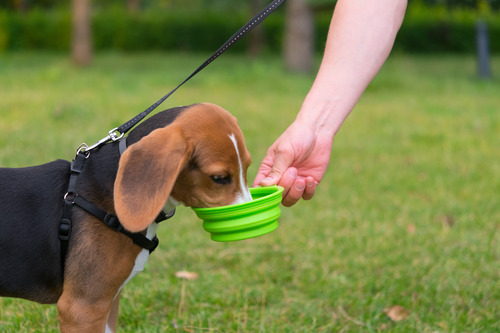Warm summer days are perfect for hiking, playing fetch, or lounging outside with your pup. But when temperatures rise in Boulder, the heat can quickly turn dangerous for dogs. Dog heatstroke is a serious, life-threatening condition that develops when a dog’s body overheats and cannot cool itself down. This blog will explore how to protect your pet during hot weather to help you avoid emergencies and keep outdoor activities safe and fun all summer long.
What is Dog Heatstroke?
Dog heatstroke happens when a dog’s internal temperature rises beyond what the body can handle. Unlike humans, dogs cannot sweat effectively to release heat. They rely on panting and limited sweating through their paw pads to regulate temperature. When their cooling mechanisms fail, their body temperature can rise quickly, leading to organ damage and other complications. Certain breeds and dogs with specific health conditions are more vulnerable. Flat-faced breeds like Bulldogs, Pugs, and Shih Tzus have shorter airways, which makes panting less effective. Overweight dogs, senior dogs, and pets with heart or respiratory issues are also at higher risk.
Signs of Dog Heatstroke Every Pet Owner Should Know
Recognizing early warning signs allows you to take quick action and get help before the situation becomes severe.
Early Signs
- Heavy panting that doesn’t slow down
- Drooling more than usual
- Lethargy or unusual tiredness
- Trouble maintaining balance
Advanced Signs
- Vomiting or diarrhea
- Bright red or pale gums
- Rapid heartbeat
- Confusion or collapse
When temperatures soar in Boulder, knowing these signs of dog heatstroke can make a life-saving difference.
Common Situations that Put Dogs at Risk
Heatstroke doesn’t just happen on the hottest days of summer. It can occur in several everyday situations that may seem harmless at first.
Inside a Parked Car
Even with windows cracked, the inside of a vehicle can climb to dangerous temperatures within minutes. This is one of the most common and deadly causes of dog heatstroke.
Outdoor Exercise
Running, hiking, or long walks in the midday sun can overwhelm your dog’s ability to cool down. Pavement also absorbs heat, raising your dog’s body temperature through their paw pads.
Hot Indoor Spaces
Garages, enclosed patios, or poorly ventilated rooms without air conditioning can trap heat and put your dog at risk even when outside temperatures feel comfortable. By being mindful of these scenarios, you can take steps to avoid putting your pet in danger.
Simple Prevention Tips for Dog Heatstroke
You don’t need to skip summer fun to protect your dog. With a few practical adjustments, you can help your pet stay safe and cool.
- Adjust Exercise Times: Take walks early in the morning or later in the evening when the sun is lower and temperatures are cooler. Avoid strenuous play during midday heat.
- Provide Constant Access to Water: Hydration is key to regulating body temperature. Always bring fresh water with you, whether you’re walking around Boulder or heading out for a hike.
- Create Shady Resting Spots: If your dog spends time outdoors, make sure they have access to shaded areas. Trees, covered patios, or portable canopies provide relief from direct sun exposure.
- Protect Heat-Sensitive Breeds: Short-nosed breeds, older dogs, and those with health concerns should have limited outdoor activity during hot weather. A few minutes outside is often enough.
Dog Heatstroke in Colorado’s Climate
Boulder’s elevation and climate create unique challenges for pet owners. The higher altitude means the sun feels stronger, and thinner air makes cooling off more difficult. Summer days often start cool but heat up quickly, which can catch pet owners off guard. If you’re planning hikes in the Flatirons, a day at the park, or any outdoor adventure, always consider how your dog handles the elevation and temperature changes. Many local trails have limited shade, which increases the risk of dog heatstroke during the warmer months.
Traveling and Outdoor Adventures with Your Dog
Boulder offers endless outdoor opportunities, but safety must come first. Whether you’re heading to Chautauqua Park, Boulder Creek, or a mountain trail, keep heat protection in mind.
Hiking with Your Dog
Bring extra water for both you and your pet, and take frequent breaks in shaded areas. Avoid rocky or exposed trails during the hottest parts of the day.
Road Trips
Never leave your dog alone in a parked car, even for a short stop. Instead, plan pet-friendly routes and rest stops where your dog can stretch and stay cool. By planning ahead, you can explore Colorado with your pet without exposing them to dangerous situations.
When to Seek Veterinary Help at Boulder Veterinary Hospital
Heatstroke is always an emergency. If you suspect your dog may be overheating, immediate veterinary care is necessary. Quick action can make the difference between recovery and serious complications. At Boulder Veterinary Hospital, our team is prepared to care for dogs affected by heat-related conditions. If your dog shows signs of dog heatstroke, call us right away at (303) 442-6262 or book an appointment online.
Protecting Your Dog During Colorado Summers
Summer in Boulder is best enjoyed when your dog is safe and comfortable. When you’re able to recognize the signs of dog heatstroke, avoid risky situations, and practice simple prevention strategies, you give your pet the chance to thrive in every season. If you ever have concerns about your dog’s health in hot weather, the veterinary team at Boulder Veterinary Hospital is here to help. Call us at (303) 442-6262 or book an appointment online to keep your dog safe all year long.





